| Home > Hamono > Knife Polishing |
|
Kiya Yanagi-ba "Hat" model (Restoration of a very old knife. May 23)
Kiya is a very very famous brand in Japan, probably the most famous and the largest knife brand. They even carry Shigefusa knives under their label (sometimes). My mom has three Kiya knives, one being her stainless daily Gyuto knife, the other two, a deba and a yanagi-ba. I have been sharpening these knives since I was a kid for her, so the name Kiya bring back many memories.
People outside of Japan probably think that Masamoto and Aritsugu is the most popular brand, but Kiya is actually without doubt the best seller, and their knives live up to their fame. They have a huge shop in the center of Tokyo, Nihonbashi, where Toukai-dou (road traveling thru Japan) starts. During the Edo period this city was the busiest in Japan, people going in and out of Edo city. Imagine a huge knife shop, situated in such location.
This one, judging from the size (such small yanagi is not used by professionals so it is for the house kitchen, and the thin handle shows that these are made for ladies) and the finish, it is probably economy model, but it is made very nicely. This is probably why Kiya is trusted by so many chefs and house wives. It is a Shirogami (White Steel) knife, but probably from the age hardening, the steel was quite hard, I had to try several coarse stones (I started from Sigma C 240, and then Imanishi 400, but neither worked too well) until I was comfortably grinding this steel. Oh! speaking of the coarse stone, I think I have to recommend "Sigma Power's Knife Sharpening Green Carbon Stone for Professionals", which I used this time (not the one shown here, the shown one is the Imanishi stone, which is usually very good with knives, but 400 was a bit too fine for the coarse grinding I had to do for this knife). This was the first time I used this stone, but wow, it was great! It's not the hardest of coarse stones (Sigma's Carbon stone, the black one, is much harder) but it just suited knife grinding so much, really fast and bites very well so easy to control. I'll list this stone in the Sigma Power page.
Altho there was a bit of surface rust, this knife turned out to be in the best shape for a restorer out of all the knives I've polished in the past, apart from the Shigefusa knives. This knife seems to be quite old, but the steel was not warped, the back was basically completely flat, and the back hollow was in a very very healthy condition (you can see from the ito-ura I managed.)
Original condition



It doesn't look like there's any hollow. I'm wondering how the user was sharpening this knife.
===
Restoration
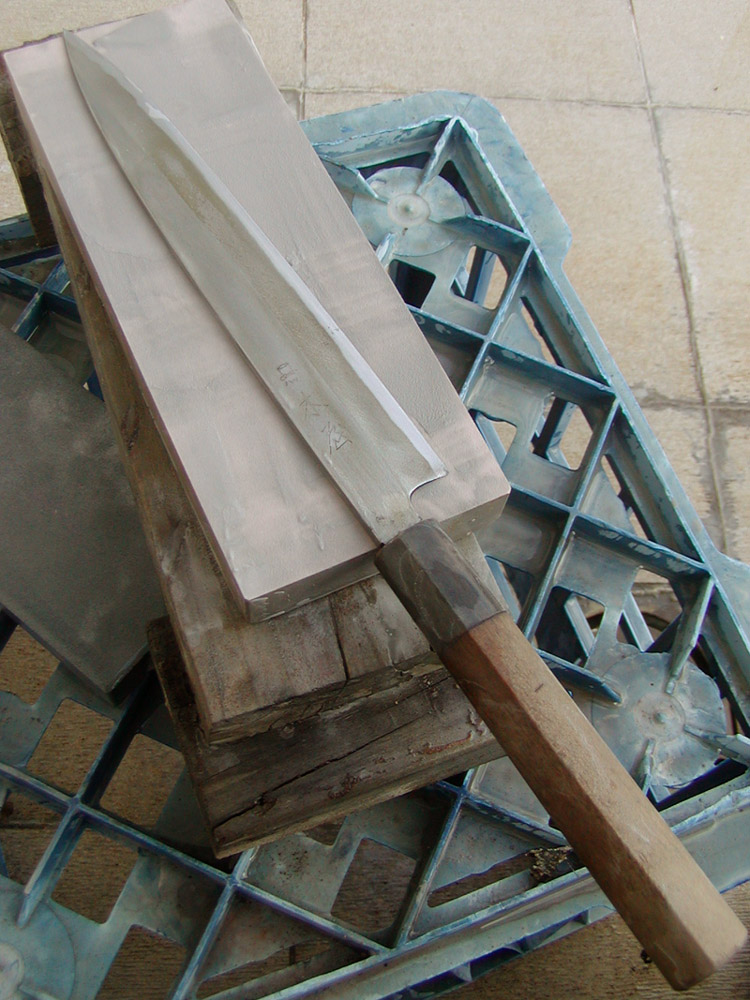
Having said that, since it is not a hand finished knife, the bevel (shinogi) and the flat (hira) was bumpy (from grinding wheel), I had to fix both to make the the bevel line (shinogi-sen) nice and flowing, so no part of this knife is untouched, the bevel, the flat, the spine, the back, the back hollow, and of course the handle.
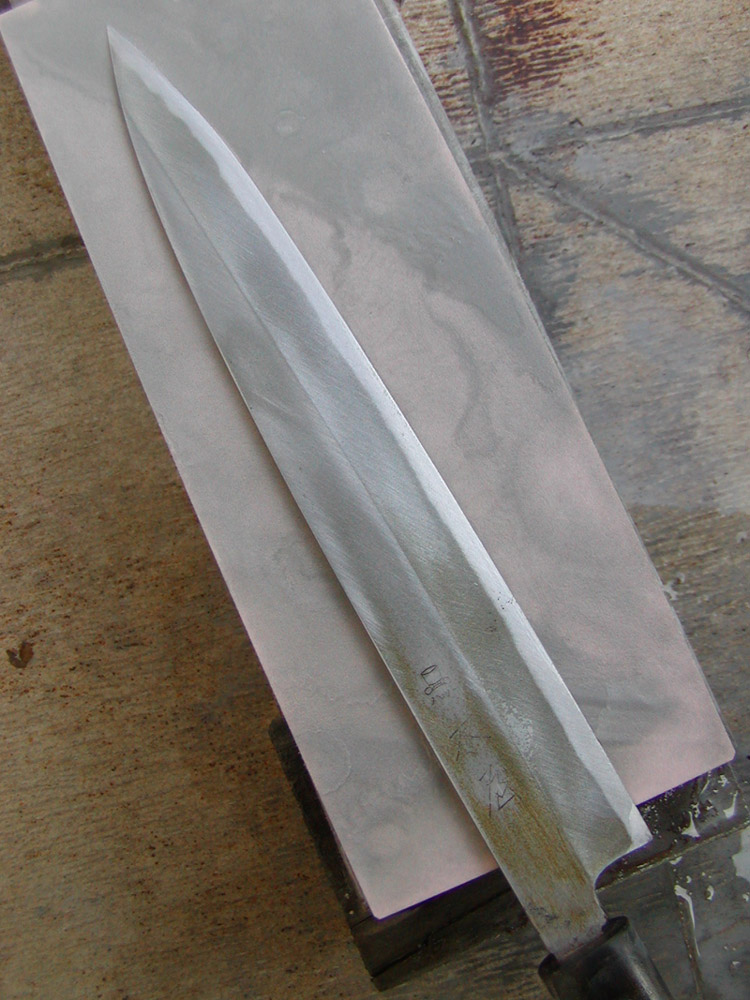
You can see where it is concaved and convexed from the serration mark colour. Where it's bright is where it's high, and darker part is the lower parts. It takes just a bit of knowledge and skill to fix this completely, and it is the most important and the time consuming step (I spent two days) out of all the polishing process, because this ara-togi (coarse grinding) decides the shape of the knife.
This is where the togi-shi (polisher) expresses oneself, I suppose.... But of course the expression has to be in tune with the original shape of the knife. This designing aspect of knife polishing can be studied thru Japanese sword polishing. No knife polishing books probably refer to this aspect, considered as tacit understanding I suppose, altho it is a very important aspect a polisher should be aware of. The balance between the spine curve and the edge curve, and where to place the shinogi-sen, etc.

My sensei's knife on the left. Who? Of course Shigefusa~~~. Their polishing is the best in Japan for sure. In this blurry photo my polishing looks okay, but there's still a bit of a difference between the two.... A space to improve. All of you who have Shigefusa should know how immaculately polished Shigefusa knives are. I feel that it is worth getting their knives just to study this polishing. I am even keeping this yanagi unused to study their polishing! When I polish someone's knife, I still pull out this knife and compare to check if my polishing is good enough, beacuse sometimes people pay considerable amount to me to have their knife polished. Any Shigefusa and Heiji knives (and of course any knives that you got from me) are polished for free tho, regardless of which seller you got it from, and how bad the condition may be!
Handle sanded to clean the surface and fix the dent, and oiled. The ox horn ferrule polished using a compound. Shigefusa's ferrule is so shiney, I wonder if it's simply polished more and buffed, or the handle maker is using some sort of coating (probably not)??? But because it is so highly polished, it looks plasticy sometimes, so I kind of prefer kasumi (hazy, semi-mirro polished) finish for the ferrule as well.
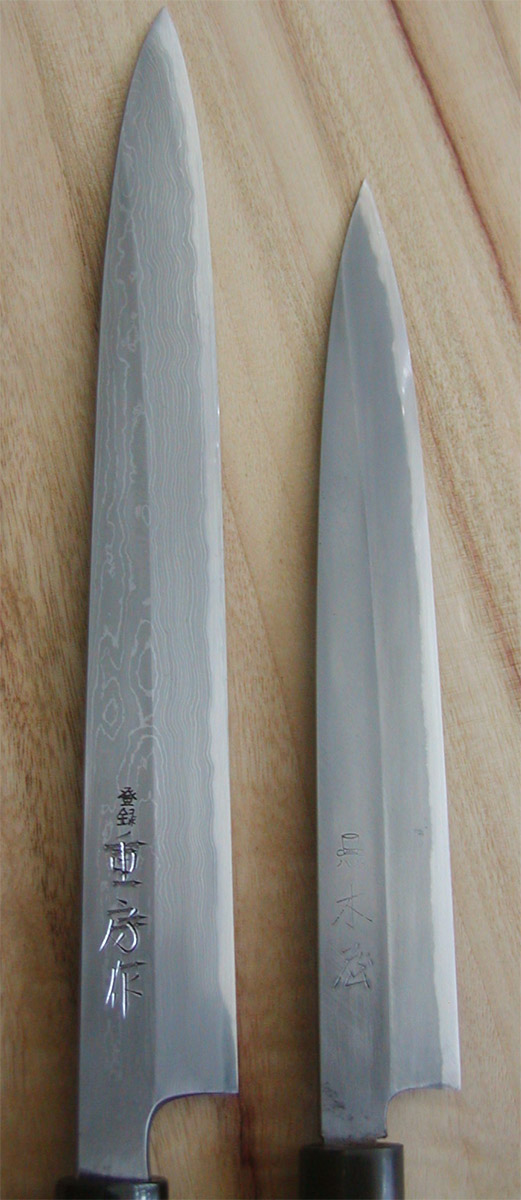
I am reqeusted by Shigefusa not to go into to too much detail regarding their special polishing technique, but it took me 4 days to bring to this state. I wonder how Shigefusa manages to make any profit finishing their knives in this fashion. There's really no wonder they take more than a year to deliver these days.... The price is way too cheap.
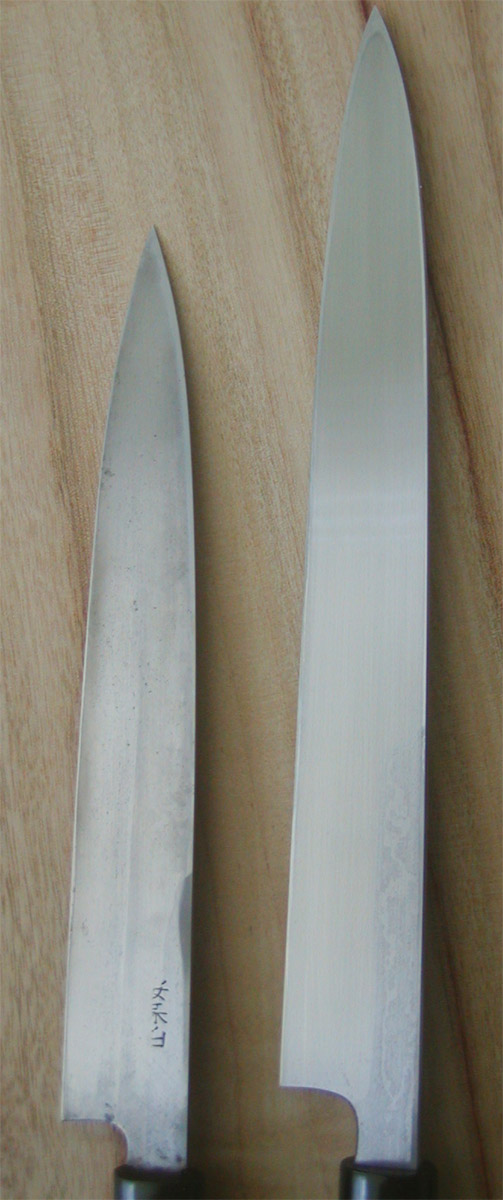
The ura was in superb condition. Because the back hollow was so~~~~ healthy, when the user sent me the photo in the beginning to let me check if it's worth the repair, I totally thought that she somehow flattened the back hollow out completely, beacuse it was so invisible.
The thin ura on the edge side makes it very easy to polish the edge to precision, called ito-ura (thread back), it is important to keep this condition as you use and sharpen until you use up the knife (not to use anything but the final finishing stone for the back, and also to press only the edge side, and try to keep the spine side ura as thin as possible), and return to the maker to order another (this is the best way to show appreciation to the maker, I hear that they sometimes even send a new one for free if the knife has been used up so nicely). The ura is so thin, it's even comparable to Iwasaki razors! I might have went a bit too far thinning the ura.... hahaha.
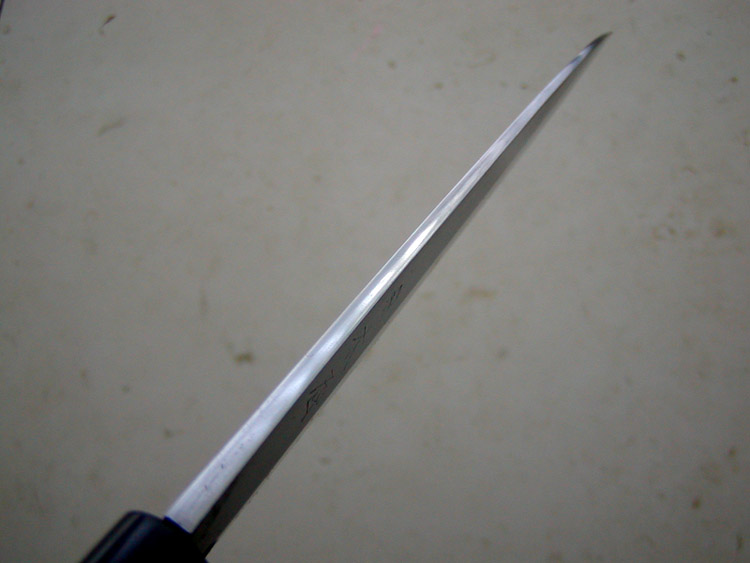
Shigefusa style rounded polished spine.
Now this Kiya knife is almost Shigefusa quality!
===
Knife Polishing 1
Fine polishing a brand new knife. Hon-kasumi finish using sword polishing technique.
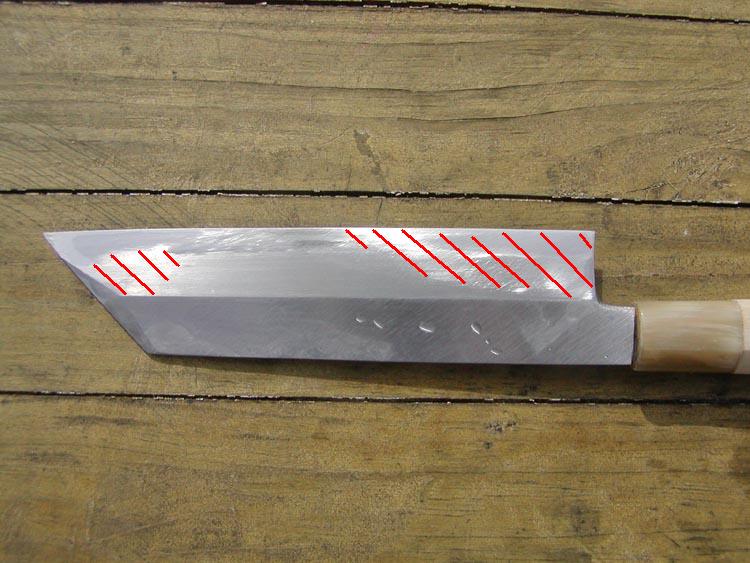
The area covered with red lines are touching the stone. The rest of the bevel has been over ground by grinders, when it was sharpened at the factory.
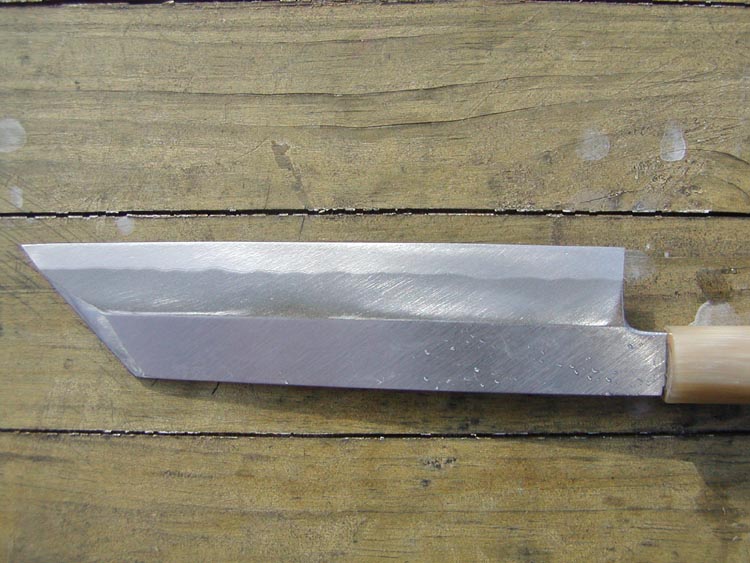
3 hours later after grinding on #220.... You can still see the parts that are not touching the stone (where it's brownish with rust).
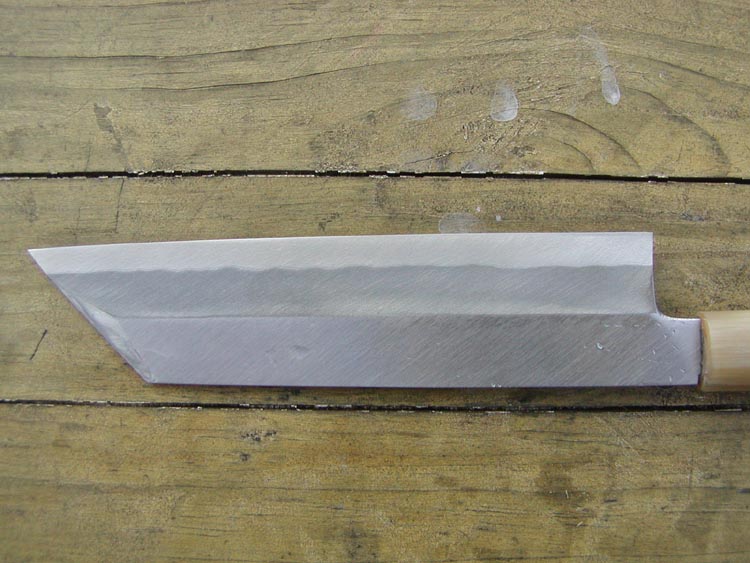
2 hours later. Now the coarse marks are erased with #1000 and #2000.
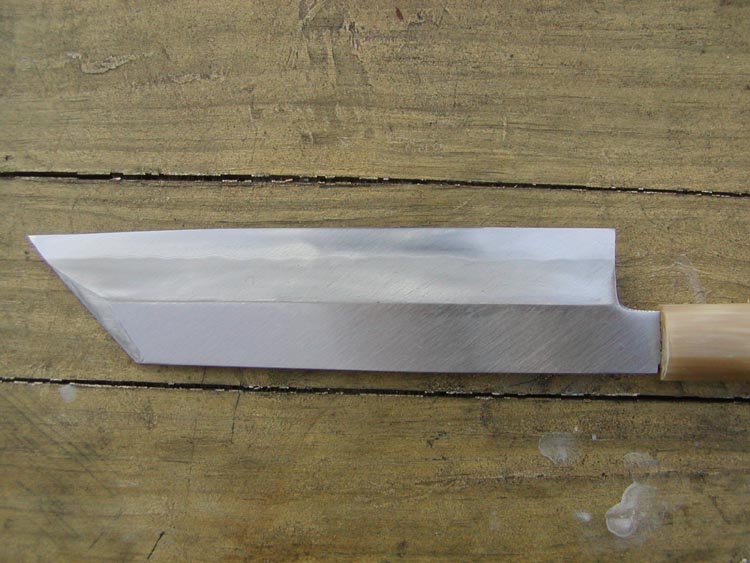
Marks from Snythetic stone are erased by Aoto (I used Inokura).

After Ohira Suita med fine finishing stone. This stone will be the equivalent to Maruoyama Suita.
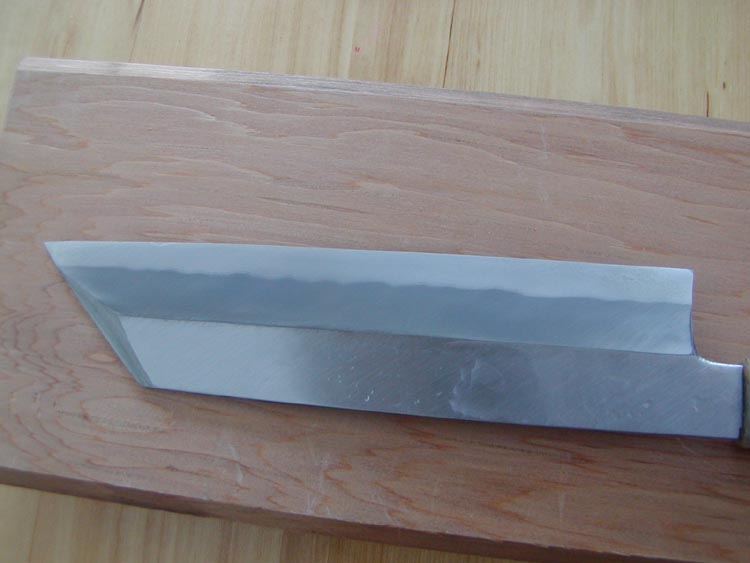
After spending 3 hours on Mizukihara Tomae, the final finishing stone. This process is very important since it decides the final outcome. You need to use your best stone in order to keep the jigane unscratched, otherwise when you go onto the Uchigumori polishing, you won't be able to erase the scratch.
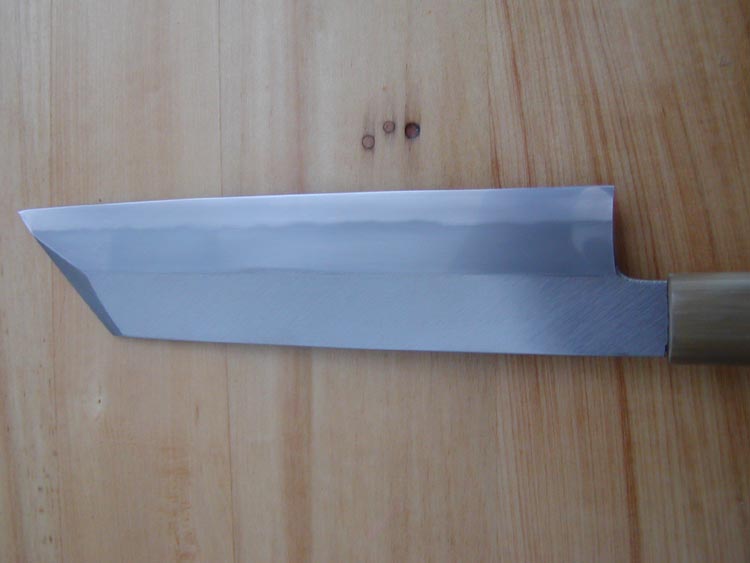
Complete. The jigane is polished to semi hazy semi shiny state, using Narutaki Uchigumori stone. The dark shadow at the end of the blade is my body reflecting onto the blade. You can see, it is hazy, but still reflects things like a mirror.
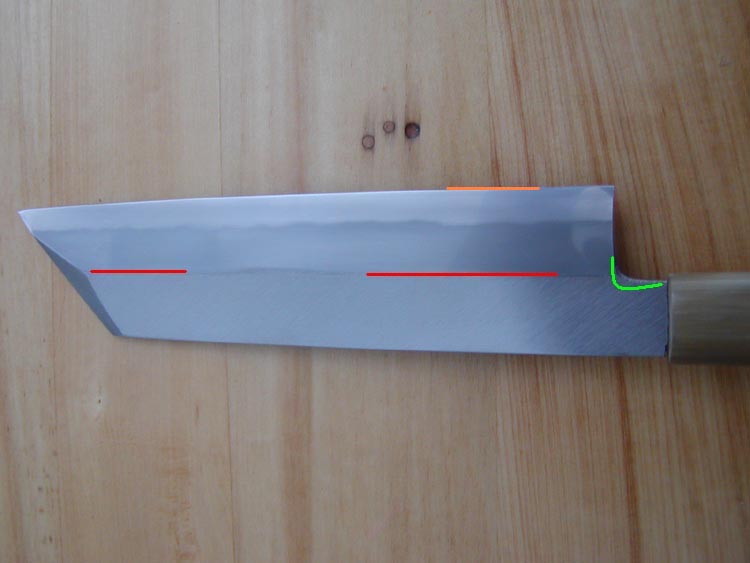
Because part of the bevel line was over ground at the factory shaprening, where it is not marked with the red line is not touching the stone. In order to make the bevel line perfect (sharp edge with no rust), you have to grind the neck a little bit as shown in light green line, so that the bevel line can be lowered (= brought up closer to the spine side) a bit more.
Also, part of the back was just a little bit over ground as well, so the edge marked with orange line is a bit concaved. In order to fix this concavity, I have to further grind the back, but that would broaden the area where it touches the stone (makes the hollow smaller), so I kept it as it is but managed to fiddle it a bit and made the edge sharp.
I guess this kind of subtle imperfection can only be detected when it is actually polished by hand.
It took three days and total of about 10 hours to complete.
===
Knife Polishing 2
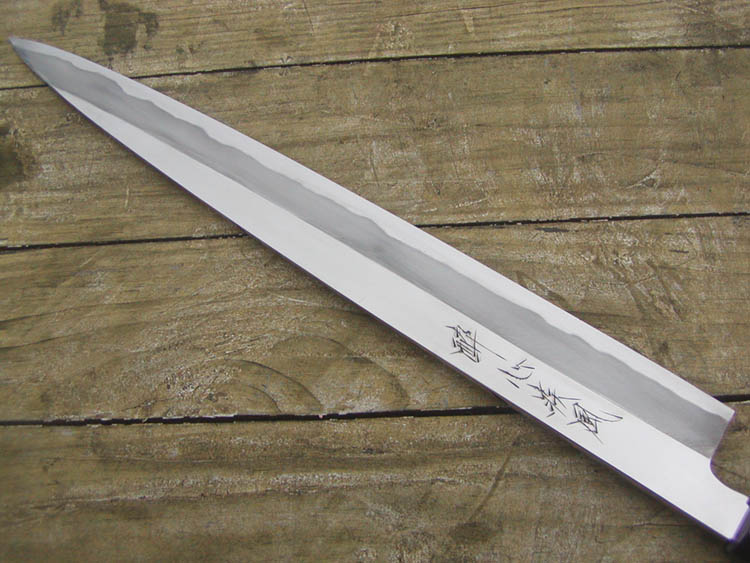
This yanagiba has been used, shapened and polished by myself many times, but some parts of the shinogi is still not flat enough. Darker spots where shown with red lines are dented from water wheel polishing. In order to make the kasumi completely even looking, these parts needs to be fixed, but if I try to make it even in one go, I'd have to grind a lot of steel, so I'm fixing it little by little. It'll probably take more than 10 more times until the shinogi will look completely even, like the first knife shown above.
So far Shigefusa and Heiji are the only knives that doesn't require this shinogi flattening process. That is because they are both hand polished by the blacksmiths themselves using the natural stone instead of the grinding wheels.
===
Repairing a Mukimono knife
My J chef friend's knife. It is a very old knife, using a Rentetsu type of jigane, it was warped very badly to the steel side, basically unsharpenable (uraoshi cannot be done). So, I had to start from roughly fixing the warp by re-bending to the jigane side, which is quite scary because if you don't becareful the blade can snap right in half, but if you are too gentle the warp would never get fixed. If the blade snaps, then,,,, I'm stuffed. In accordance with strict Japanese tradition, I'd have to commit a Seppuku using the snapped tip of the knife....
Just kidding.
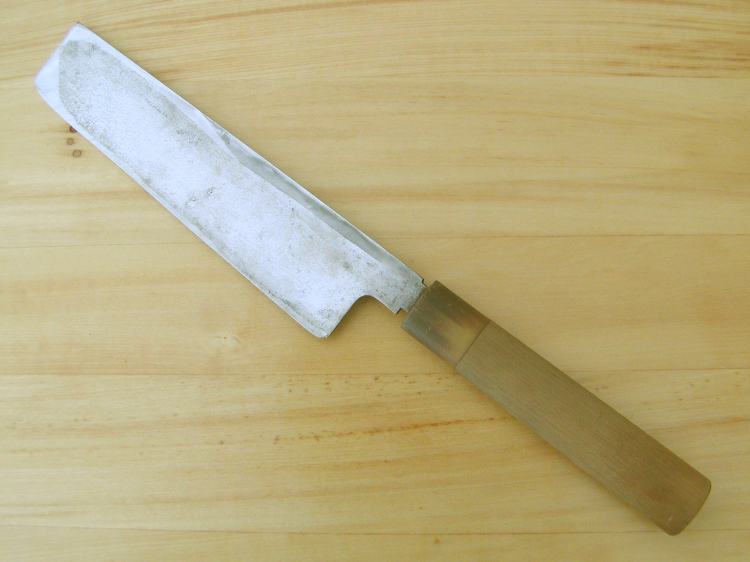
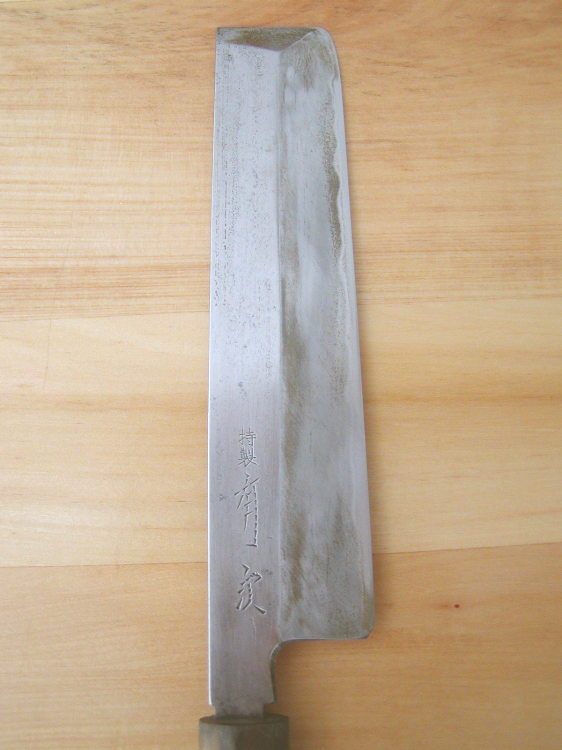
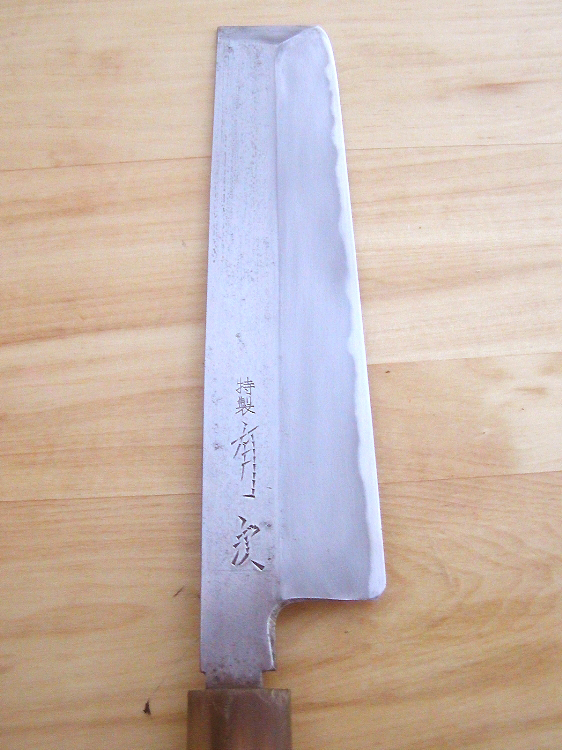
Hon Kasumi finish using very soft and fine Nakayama Suita to prepare the jigane and finished by Oohira Uchigumori finger stone. The steel part is polished to a higher sheen with harder and finer Nakayama Asagi.
People sometimes ask me if Kasumi finish is a smoky scratchy finish done by a coarse stone. If you look at this photo, it may seem so, but if you look at the below photo, you can see how highly polished it is. This is the magic of the natural stones. No synthetic stone can finish like this. For finishing knives and swords, natural stones are still essential.
Synthetic stones are now widely used for sword polishing, because of the diminishing numbers of high quality natural stones, but even still, it is only up to the medium finishing. The final 3 to 4 stones are still all natural stones, as well as the finger stones. Sword polishing requires the highest quality stones because single scratch would cost so much time to fix, and each sword's Tamahagane (the special steel used to forge J swords) property is different, so the polisher needs to carry multiple stones of the same type of stone (for instance Uchigumori, Suita, Koma Nagura, etc) to match with the steel.
But in fact, such high quality stones are getting rarer and rarer, more and more expensive, so I am a bit worried about the future of J sword polishing.... So far the synthetic stone makers are nowhere near being successful in making the finishing stone that can replace the final 3 to 4 natural stones. But unless we can somehow come up with a substitute, the tradition of J sword polishing will come to an end in maybe next one or two generations! Living in a world where computers and machines are doing unbelievable things, it's hard to believe that a "single stone" cannot be replaced even with the best of the modern technology.
But then again, that is one of the reason why I am so attracted to the natural stones....
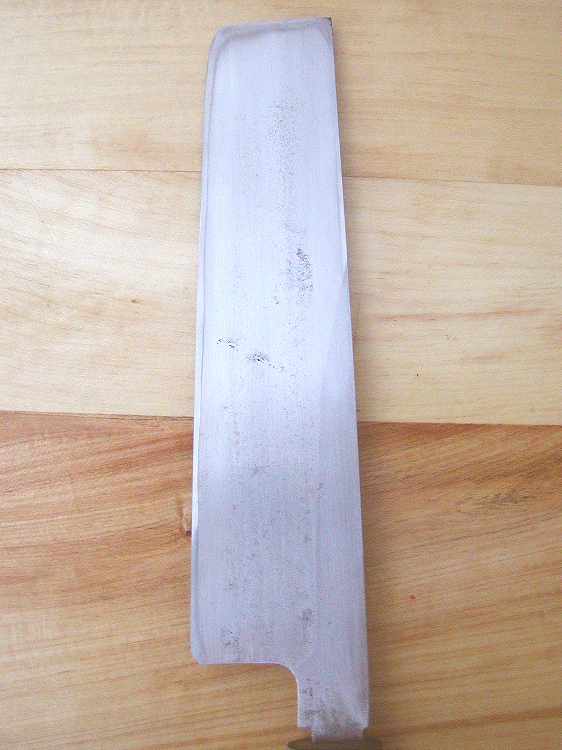
Back hollow fixed. I fixed the back hollow in a hurry, so the shape of the rim of the back hollow doesn't look as neat as the one show below.
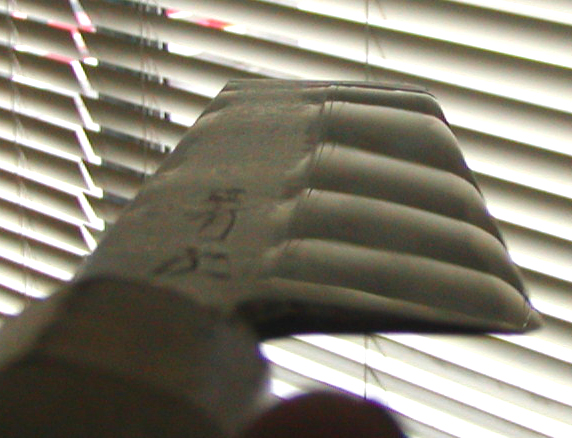
Highly polished Kasumi finish.
===
Repaird back hollow of a Yanagiba knife
I forgot to take the photo of the initial state, but the back hollow was diminished to 50% of it's original size. Again my chef friend's knife. This one I spent full two days fixing only the back, so it is really neatly finished. Almost Shigefusa quality?(^^)

Knife Polishing 3
Shigefusa Kasumi Yanagi-ba
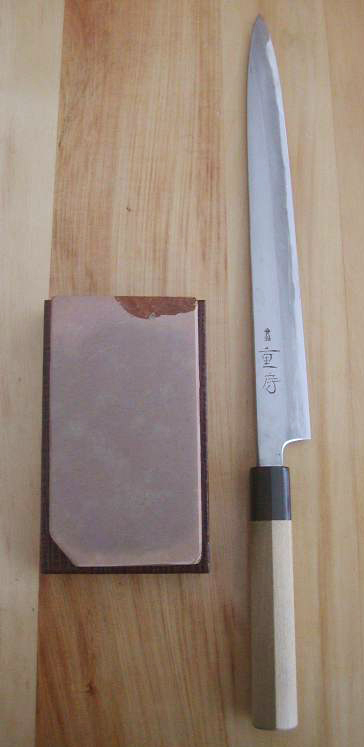
The stone is the one I will be using to polish this knife. The knife is already quite well polished, but with a synthetic stone, so all I need to do is replace the visible marks with the natural stone's frosted hazy finish, and finish off the jigane with Oohira Uchigumori finger stone.
This is the first time I received a Shigefusa knife from a customer, so I'm very excited to polish it for him.

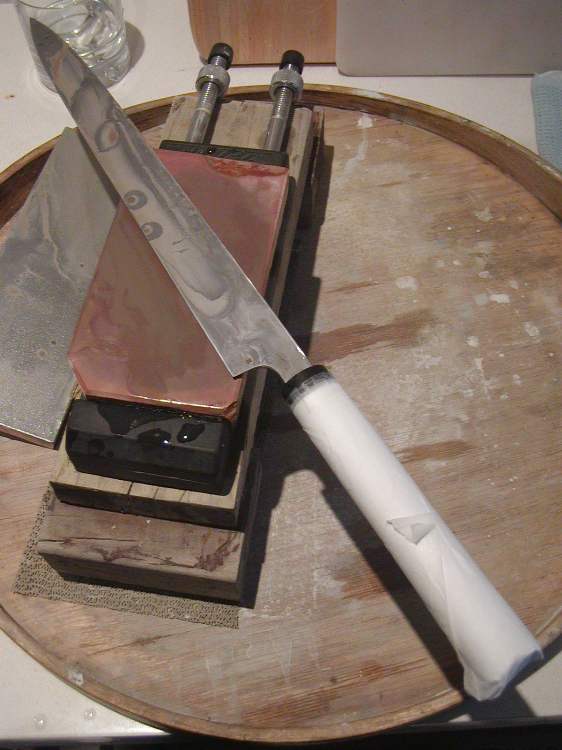
Nakayama super fine finishing stone. This stone is sold to the owner of this yanagi-ba knife.
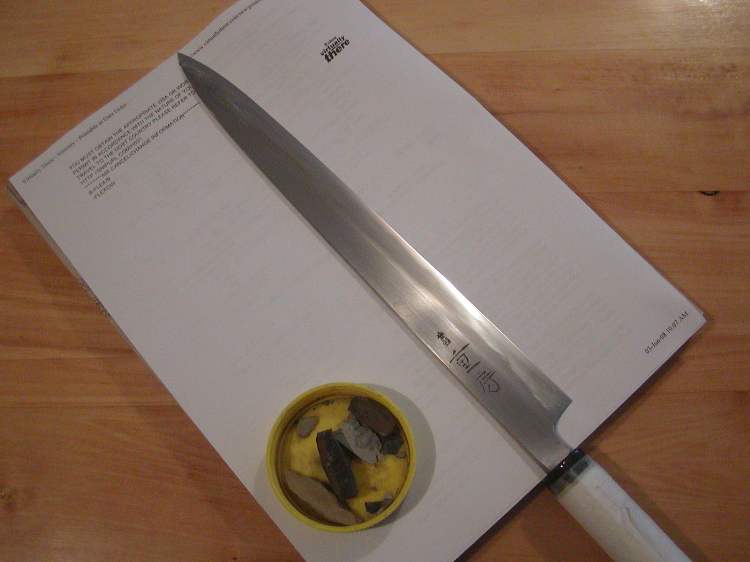
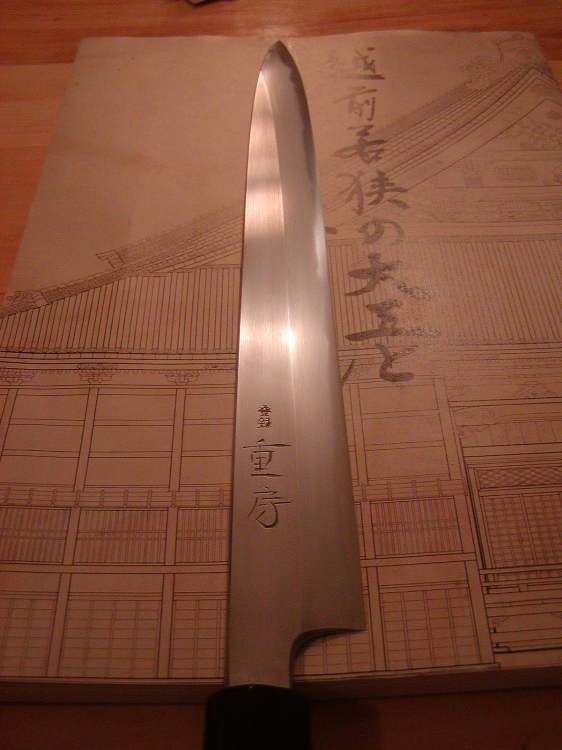
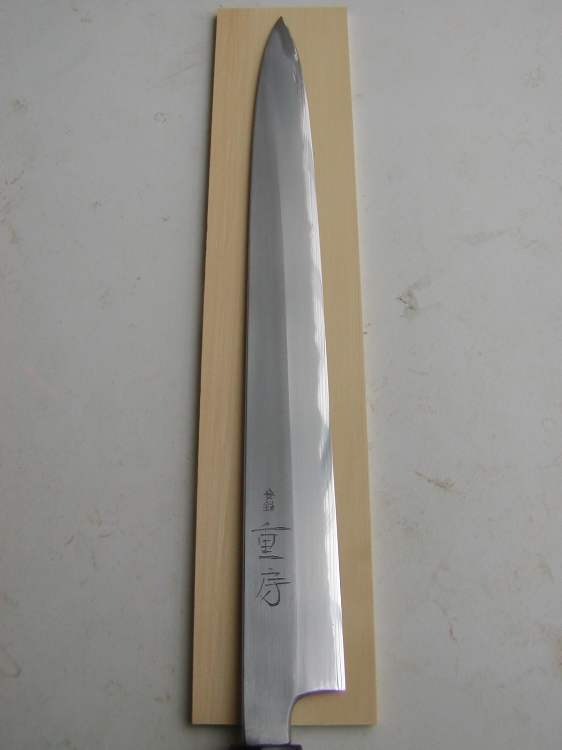
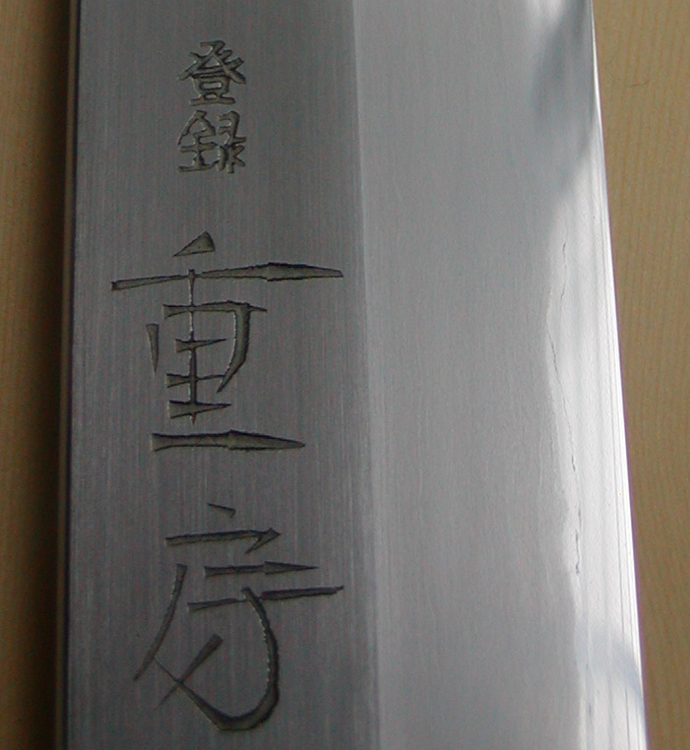
Shigefusa uses a very old jigane stock, which has a bit more impurites contained compared to the modern soft steel. When it's polished up to this level, of course with a fine natural stone, you can see its delicate damascus like pattern on the jigane. What a luxruy, becaues probably no one will notice this....
